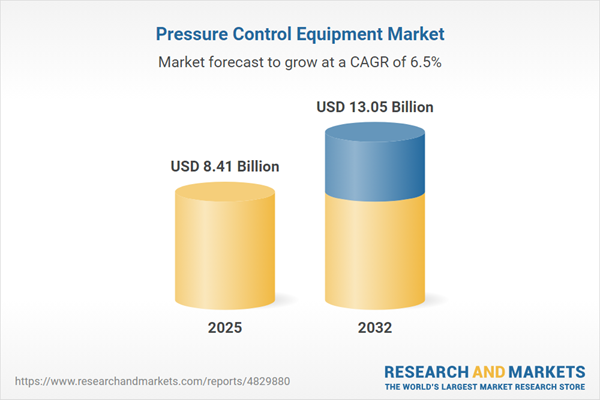Speak directly to the analyst to clarify any post sales queries you may have.
The pressure control equipment market is evolving rapidly as senior executives worldwide navigate stricter regulations, advancing digitalization, and disruptive supply chain dynamics. For organizations demanding both reliability and compliance, adapting procurement and operational strategies is essential to maintain high performance amid complexity.
Market Snapshot: Global Pressure Control Equipment Market
The global pressure control equipment market is set to achieve a value of USD 7.89 billion in 2024, with a projected increase to USD 8.41 billion in 2025 and an anticipated USD 13.05 billion by 2032. Industry growth is propelled by increasingly stringent regulations, the widespread uptake of digital process technologies, and rising expectations for workplace safety. Key sectors—including oil and gas, chemicals, pharmaceuticals, and power generation—are prioritizing solutions that deliver operational robustness and efficiency. Enterprises with wide-reaching assets are focusing on advanced pressure control solutions to secure resilience and ensure strategic continuity amidst ongoing marketplace shifts.
Scope & Segmentation in the Pressure Control Equipment Market
Addressing the diverse regulatory and operational requirements present in global industry, effective navigation of this market depends on strategic segmentation. Senior leaders gain competitive advantage by tailoring investments to match product type, technology, and regional demand.
- Valve Types: Ball, check, diaphragm, gate, and globe valves each support customized flow management and process reliability, vital to performance in manufacturing and processing.
- Actuation Types: Electric, hydraulic, pneumatic, and manual actuators facilitate sector-specific flexibility, enabling organizations to automate control or provide instant system responses in critical environments.
- Material Types: High-grade alloys, including stainless, carbon, and alloy steels, are central to compliance and product durability, especially in regulated or corrosive operating conditions.
- Operation Modes: Options for automated and manual operation allow businesses to transition rapidly as process needs evolve, ensuring oversight and agility.
- End Industry Applications: Pressure control equipment is integral for industries such as oil and gas, chemicals, pharmaceuticals, water management, and power generation, where uninterrupted processing and enhanced safety are required.
- Geographic Regions: Active markets persist across the Americas, EMEA, and Asia-Pacific. Distinct challenges and opportunities define major countries including the United States, China, Germany, India, Brazil, and South Africa, each contending with their own procurement and compliance realities.
- Leading Market Participants: Prominent suppliers such as Emerson Electric Co., Flowserve Corporation, Schlumberger Limited, ABB Ltd., Honeywell International Inc., Parker-Hannifin Corporation, Baker Hughes Company, Spirax-Sarco Engineering plc, Yokogawa Electric Corporation, and Siemens AG continue to prioritize product innovation and advanced technology solutions.
Key Takeaways for Senior Decision-Makers
- Advanced pressure control systems increase operational stability while supporting rapid adaptation to changing compliance demands.
- Digital diagnostics and remote monitoring underpin proactive maintenance, reducing downtime and maintaining process integrity across distributed assets.
- Specifying corrosion-resistant materials extends equipment lifespan, aligning investments with sustainability and life-cycle outcomes.
- Comprehensive cybersecurity protocols now form a core component of digitalized operations, protecting business-critical functions and sensitive data as connectivity expands.
- Partnering with established technology providers accelerates innovation adoption, ensuring business units maintain compliance and integration readiness.
- Procurement strategies built on compliance-forward frameworks drive resilience, enabling businesses to flexibly navigate international regulatory shifts.
Tariff Impact: Supply Chain and Sourcing Considerations
Forthcoming US tariffs in 2025 are prompting a strategic reassessment of sourcing models within the pressure control equipment sector. Companies are responding by emphasizing regional supplier networks and increasing production localization to better manage volatility and satisfy shifting buyer demands. The adoption of diversified and agile procurement processes is enabling organizations to minimize exposure to policy fluctuations and sustain supply chain continuity. This is particularly important for those in emerging markets, where requirements for compliance and supply stability are rapidly evolving.
Methodology & Data Sources
This research is informed by interviews with leading industry professionals, thorough technical reviews, and trusted industry databases. The methodology ensures actionable insights tailored for executive-level decisions across market segments and regions.
Why This Pressure Control Equipment Market Report Matters
- Enables senior leaders to align sourcing and investment with current regulatory and marketplace realities.
- Guides technology adoption and compliance initiatives with relevant benchmarks and practical recommendations.
- Establishes a foundation for organizations to enhance operational adaptability and performance through innovation in diverse industries.
Conclusion
Maintaining agility and strategic focus is essential in the pressure control equipment market as decision-makers address continuous regulatory, technological, and market evolution. Effective engagement ensures ongoing operational strength and growth opportunities worldwide.
Additional Product Information:
- Purchase of this report includes 1 year online access with quarterly updates.
- This report can be updated on request. Please contact our Customer Experience team using the Ask a Question widget on our website.
Table of Contents
3. Executive Summary
4. Market Overview
7. Cumulative Impact of Artificial Intelligence 2025
Companies Mentioned
The companies profiled in this Pressure Control Equipment market report include:- Emerson Electric Co.
- Flowserve Corporation
- Schlumberger Limited
- ABB Ltd
- Honeywell International Inc.
- Parker-Hannifin Corporation
- Baker Hughes Company
- Spirax-Sarco Engineering PLC
- Yokogawa Electric Corporation
- Siemens AG
Table Information
| Report Attribute | Details |
|---|---|
| No. of Pages | 196 |
| Published | November 2025 |
| Forecast Period | 2025 - 2032 |
| Estimated Market Value ( USD | $ 8.41 Billion |
| Forecasted Market Value ( USD | $ 13.05 Billion |
| Compound Annual Growth Rate | 6.4% |
| Regions Covered | Global |
| No. of Companies Mentioned | 11 |









